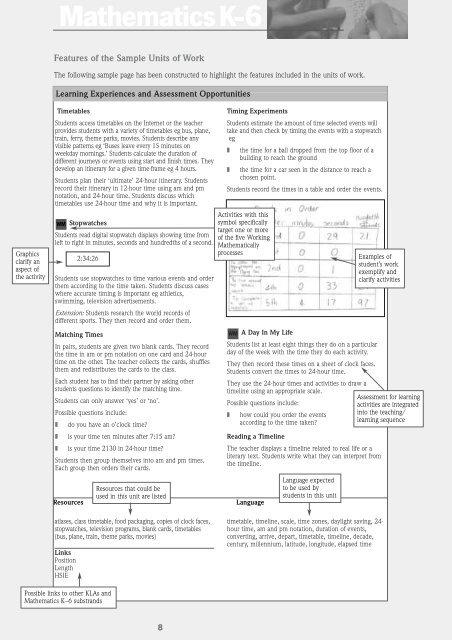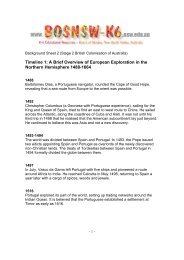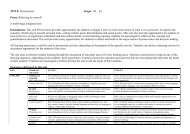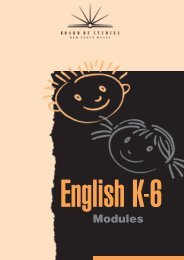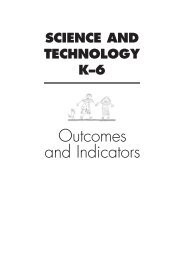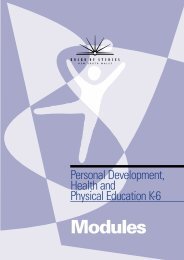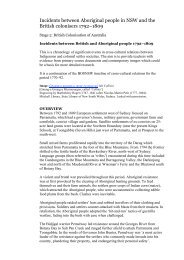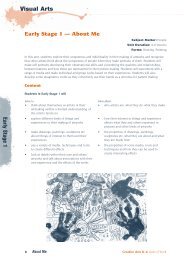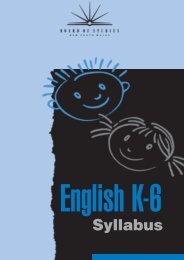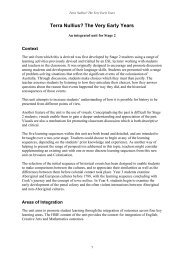Math K-6 WS - K-6 Educational Resources
Math K-6 WS - K-6 Educational Resources
Math K-6 WS - K-6 Educational Resources
You also want an ePaper? Increase the reach of your titles
YUMPU automatically turns print PDFs into web optimized ePapers that Google loves.
Graphics<br />
clarify an<br />
aspect of<br />
the activity<br />
<strong>Math</strong>ematicsK-6<br />
Features of the Sample Units of Work<br />
The following sample page has been constructed to highlight the features included in the units of work.<br />
Learning Experiences and Assessment Opportunities<br />
Timetables<br />
Students access timetables on the Internet or the teacher<br />
provides students with a variety of timetables eg bus, plane,<br />
train, ferry, theme parks, movies. Students describe any<br />
visible patterns eg ‘Buses leave every 15 minutes on<br />
weekday mornings.’ Students calculate the duration of<br />
different journeys or events using start and finish times. They<br />
develop an itinerary for a given time-frame eg 4 hours.<br />
Students plan their ‘ultimate’ 24-hour itinerary. Students<br />
record their itinerary in 12-hour time using am and pm<br />
notation, and 24-hour time. Students discuss which<br />
timetables use 24-hour time and why it is important.<br />
WM<br />
Stopwatches<br />
Students read digital stopwatch displays showing time from<br />
left to right in minutes, seconds and hundredths of a second.<br />
Students use stopwatches to time various events and order<br />
them according to the time taken. Students discuss cases<br />
where accurate timing is important eg athletics,<br />
swimming, television advertisements.<br />
Extension: Students research the world records of<br />
different sports. They then record and order them.<br />
Matching Times<br />
In pairs, students are given two blank cards. They record<br />
the time in am or pm notation on one card and 24-hour<br />
time on the other. The teacher collects the cards, shuffles<br />
them and redistributes the cards to the class.<br />
Each student has to find their partner by asking other<br />
students questions to identify the matching time.<br />
Students can only answer ‘yes’ or ‘no’.<br />
Possible questions include:<br />
❚ do you have an o’clock time?<br />
❚ is your time ten minutes after 7:15 am?<br />
❚ is your time 2130 in 24-hour time?<br />
Students then group themselves into am and pm times.<br />
Each group then orders their cards.<br />
atlases, class timetable, food packaging, copies of clock faces,<br />
stopwatches, television programs, blank cards, timetables<br />
(bus, plane, train, theme parks, movies)<br />
Links<br />
Position<br />
Length<br />
HSIE<br />
2:34:26<br />
8<br />
Timing Experiments<br />
Students estimate the amount of time selected events will<br />
take and then check by timing the events with a stopwatch<br />
eg<br />
❚ the time for a ball dropped from the top floor of a<br />
building to reach the ground<br />
❚ the time for a car seen in the distance to reach a<br />
chosen point.<br />
Students record the times in a table and order the events.<br />
WM<br />
A Day In My Life<br />
Students list at least eight things they do on a particular<br />
day of the week with the time they do each activity.<br />
They then record these times on a sheet of clock faces.<br />
Students convert the times to 24-hour time.<br />
They use the 24-hour times and activities to draw a<br />
timeline using an appropriate scale.<br />
Possible questions include:<br />
❚ how could you order the events<br />
according to the time taken?<br />
Reading a Timeline<br />
<strong>Resources</strong> that could be<br />
used in this unit are listed<br />
<strong>Resources</strong> Language<br />
Possible links to other KLAs and<br />
<strong>Math</strong>ematics K–6 substrands<br />
Activities with this<br />
symbol specifically<br />
target one or more<br />
of the five Working<br />
<strong>Math</strong>ematically<br />
processes<br />
The teacher displays a timeline related to real life or a<br />
literary text. Students write what they can interpret from<br />
the timeline.<br />
Language expected<br />
to be used by<br />
students in this unit<br />
Examples of<br />
student’s work<br />
exemplify and<br />
clarify activities<br />
timetable, timeline, scale, time zones, daylight saving, 24hour<br />
time, am and pm notation, duration of events,<br />
converting, arrive, depart, timetable, timeline, decade,<br />
century, millennium, latitude, longitude, elapsed time<br />
Assessment for learning<br />
activities are integrated<br />
into the teaching/<br />
learning sequence


